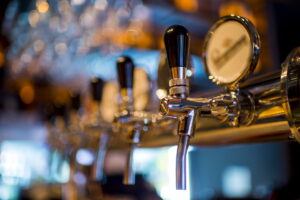Immerse yourself in Belgium's rich beer culture: 1,500 divine options!
Blond or dark, mild or strong, bitter or sweet. Belgium’s variety of beers has no limits. The production of this divine beverage is deeply rooted in the country’s cultural heritage. Today, Belgian beers are enthusiastically consumed all over the world. Picking your favourite from this abundance of glorious grain juice can be a real challenge. Let’s dive into the rich and famous beer culture of Belgium.
2.5 billion litres per year
Beer is Belgium’s national pride. On average, each inhabitant consumes around 70 litres of beer per year. To quench all those thirsty mouths, Belgium counts no fewer than 340 breweries. In 2019, they produced over 1,500 different beers, good for a staggering total of 2.5 billion litres. But the Belgians don’t drink all of it themselves. More than 70% is destined for export to countries all over the world.
A tasty history
Belgian beer culture dates back to the Middle Ages, when monks started brewing their own beers in abbeys. But the villagers liked the fresh taste of a cool beer as well, especially in the company of friends in a small pub. In 1515, the very first café in Flanders opened its doors. Since then, brewing and enjoying beer has become part of everyday life.
At the beginning of the 20th century, Belgium counted more than 3,000 breweries and over 200,000 bars. Today, traditional production methods are still handed down from one generation to the other, strengthened by the latest technology. UNESCO recognised this strongly rooted beer culture as an Intangible World Heritage in 2016.
Different types
Beer is traditionally made from water, barley and hops. By adding other ingredients, brewers change the beer’s colour, strength or taste. Belgians mainly categorise their beers into six different types. Here’s a taste:
1. Pilsners
The best known and most widely brewed beer in the world is pilsner (or as the Flemish say, a ‘pintje’). This light, golden-coloured beer contains four basic ingredients: water, malt, hops and yeast. Pilsner – often shortened to ‘pils’ – is low fermented and filtered, which makes it crystal clear. The alcohol percentage is generally around 5%. Eager to quench your thirst? Try Belgium’s Stella, Jupiler or Maes varieties.
2. Abbey beers
Today, some beers still carry the names of the abbeys from which they originated. When they meet the right criteria, abbey beers can earn the label of Authentic Trappist Product. ‘Trappist’ beers must be brewed by monks as a secondary activity within the immediate surroundings of the abbey. The abbey is not supposed to make any profit. Only eleven breweries in the world are allowed to brew Trappists. Six of them are located in Belgium: Westmalle, Westvleteren, Chimay, Orval, Rochefort and Achel.
Trappist and abbey beers come in two main types. The sweet, dark ‘double’ is rich and well-balanced. The beer gets its flavour and colour from a thick, caramelised syrup. The sharper, heavier blonde ‘triple’ has a higher alcohol content of 7 to 10%. However, there are wide-ranging flavour differences between both types. Discover them all and choose your favourites.
3. Strong blond
These are clearer than pils, but far more complex. Strong blond beers use typical varieties of hops and share a certain bitterness. Even though they have a high alcohol content, they have a silky-smooth feel in the mouth. These beers taste malty, but the addition of hops and yeast give them an aromatic flavour. Intrigued? Try Duvel. This pale ale is named after its high alcohol content (8.5%), which can turn it into a real devil, especially the day after.
4. Wheat beer
Wheat beer (or ‘witbier’) is traditionally unfiltered and somewhat cloudy. Belgian brewers add herbs such as coriander and orange zest, which gives it a fresh aroma. To strengthen the slightly sour touch, Belgian wheat beer used to be served with a slice of lemon, a tradition that has almost completely vanished. The alcohol percentage is comparable to that of pils. Do you want to give it a go? Hoegaarden is an authentic Belgian and refreshing wheat beer.
5. Lambic
This beer is one of Belgium’s oldest beer types. Over a number of years, lambic is spontaneously fermented in wooden barrels. The copper and amber-coloured beer has an unpredictable character. Therefore, brewers like to combine young and old lambics into a new beer called ‘geuze’. Old lambic has a pronounced aroma, whereas young lambic features a sour taste. Often, geuze combines flavours of citrus fruits with hints of vanilla and oak.
6. Fruit beers
The most traditional fruit beer Kriek tastes a lot like geuze, enriched by a fruity taste of mainly cherries. Over the past few decades, brewers have launched sweeter fruit beers. Usually, they are a combination of pils or white beer with fruit juice or syrup added. Stereotypically, these sweeter types of fruit beer are consumed by women or youngsters who would otherwise order a soft drink or a cocktail.
Getting thirsty? Discover the world of flavours that Belgian beer culture has to offer. And remember: drink responsibly. Cheers!
Moving to Belgium and looking for a partner to help you feel more at home? Link2Europe guides you every step of the way.



